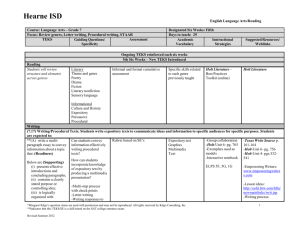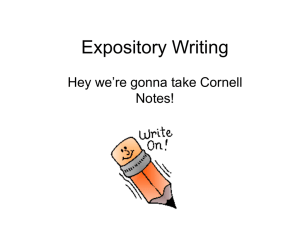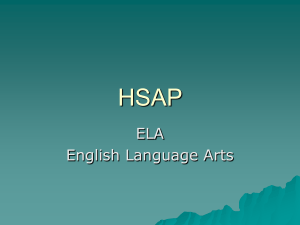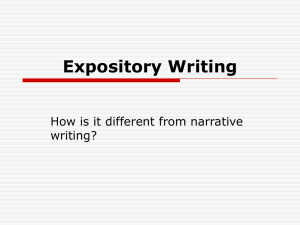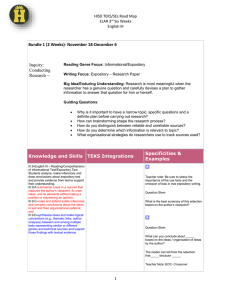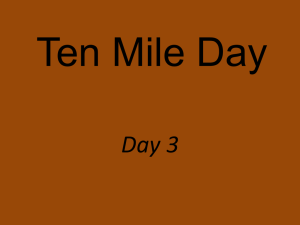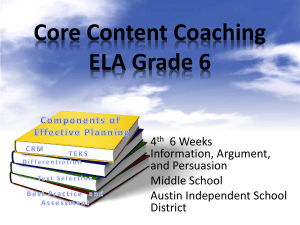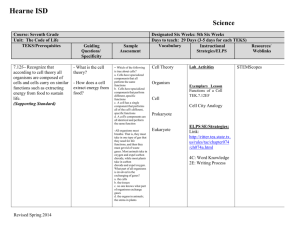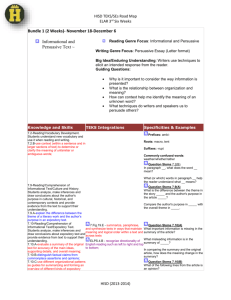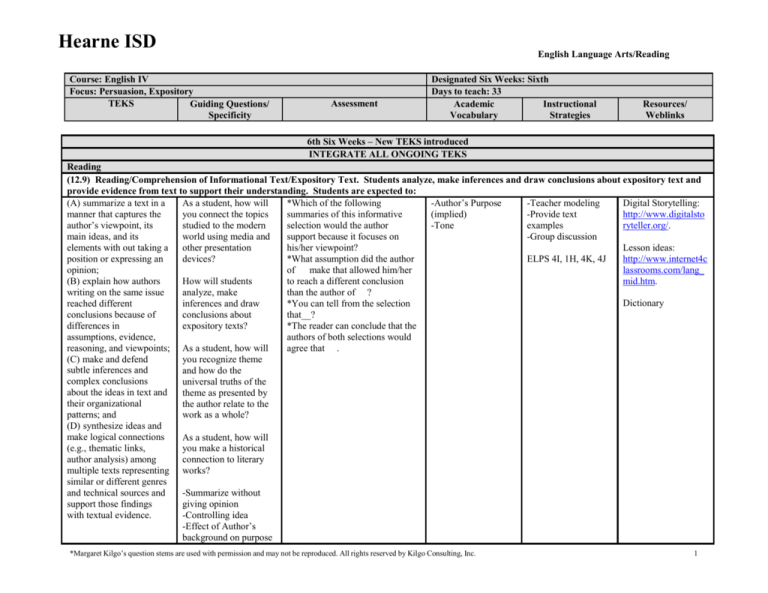
Hearne ISD
Course: English IV
Focus: Persuasion, Expository
TEKS
Guiding Questions/
Specificity
English Language Arts/Reading
Assessment
Designated Six Weeks: Sixth
Days to teach: 33
Academic
Instructional
Vocabulary
Strategies
Resources/
Weblinks
6th Six Weeks – New TEKS introduced
INTEGRATE ALL ONGOING TEKS
Reading
(12.9) Reading/Comprehension of Informational Text/Expository Text. Students analyze, make inferences and draw conclusions about expository text and
provide evidence from text to support their understanding. Students are expected to:
(A) summarize a text in a
As a student, how will
*Which of the following
-Author’s Purpose
Digital Storytelling:
-Teacher modeling
-Provide text
http://www.digitalsto
manner that captures the
you connect the topics
summaries of this informative
(implied)
examples
ryteller.org/.
author’s viewpoint, its
studied to the modern
selection would the author
-Tone
main ideas, and its
world using media and
support because it focuses on
-Group discussion
Lesson ideas:
elements with out taking a other presentation
his/her viewpoint?
ELPS 4I, 1H, 4K, 4J
http://www.internet4c
position or expressing an
devices?
*What assumption did the author
lassrooms.com/lang_
opinion;
of make that allowed him/her
mid.htm.
(B) explain how authors
How will students
to reach a different conclusion
writing on the same issue
analyze, make
than the author of ?
Dictionary
reached different
*You can tell from the selection
inferences and draw
conclusions because of
that__?
conclusions about
differences in
expository texts?
*The reader can conclude that the
assumptions, evidence,
authors of both selections would
reasoning, and viewpoints; As a student, how will
agree that .
(C) make and defend
you recognize theme
subtle inferences and
and how do the
complex conclusions
universal truths of the
about the ideas in text and
theme as presented by
their organizational
the author relate to the
patterns; and
work as a whole?
(D) synthesize ideas and
make logical connections
As a student, how will
(e.g., thematic links,
you make a historical
author analysis) among
connection to literary
multiple texts representing works?
similar or different genres
and technical sources and
-Summarize without
support those findings
giving opinion
with textual evidence.
-Controlling idea
-Effect of Author’s
background on purpose
*Margaret Kilgo’s question stems are used with permission and may not be reproduced. All rights reserved by Kilgo Consulting, Inc.
1
Hearne ISD
English Language Arts/Reading
Course: English IV
Focus: Persuasion, Expository
TEKS
Guiding Questions/
Specificity
Assessment
Designated Six Weeks: Sixth
Days to teach: 33
Academic
Instructional
Vocabulary
Strategies
Resources/
Weblinks
-Author’s viewpoint
-Connections Between
multiple texts
(12.10) Reading/Comprehension of Informational Text/Persuasive Text. Students analyze, make inferences and draw conclusions about persuasive text
and provide evidence from text to support their analysis. Students are expected to:
(A) evaluate the merits of
As a student, how will
*An accurate evaluation of the
-Swift’s “A Modest
ELPS 4J, 4K
an argument, action, or
you recognize satire
relationship between evidence
Proposal”
policy by analyzing the
and its intent as
presented in this selection and
-Various other
relationships (e.g.,
presented by the
assumptions made by the author
sources
implications, necessity,
author/poet?
would be a
.
sufficiency) among
*What conclusion can the reader
evidence, inferences,
As a student, how will
make about the credibility of this
assumptions, and claims in you recognize theme
information based on assumptions
text; and
and how do the
made by the author?
(B) draw conclusions
universal truths of the
theme as presented by
about the credibility of
persuasive text by
the author relate to the
examining its implicit and
work as a whole?
stated assumptions about
an issue as conveyed by
How will you make
inferences and draw
the specific use of
conclusions about the
language.
varied structural
patterns and features of
literary nonfiction?
As a student, how will
you connect the history
of England to literary
works?
-Claim
Writing
(12.15) Writing/Expository and Procedural Texts. Students write expository and procedural or work-related texts to communicate ideas and information
to specific audiences for specific purposes. Students are expected to:
(C) Write an interpretation Write:
Rubric based on SE
Commentary
ELPS 4K, 5E, 5F,
Guide:
*Margaret Kilgo’s question stems are used with permission and may not be reproduced. All rights reserved by Kilgo Consulting, Inc.
2
Hearne ISD
English Language Arts/Reading
Course: English IV
Focus: Persuasion, Expository
TEKS
Guiding Questions/
Specificity
of an expository or literary
text that:
(i) advances a clear
thesis statement;
(ii)Addresses the
writing skills for an
analytical essay including
references to a
commentary on quotations
from the text;
(iii) Analyzes the
aesthetic effects of an
author’s use of stylistic or
rhetorical devices;
(iv) Identifies and
analyzes ambiguities,
nuances, and complexities
within the text;
(iv) Anticipates and
responds to readers’
questions and
contradictory information.
Assessment
Designated Six Weeks: Sixth
Days to teach: 33
Academic
Instructional
Vocabulary
Strategies
A literature
interpretation
*Margaret Kilgo’s question stems are used with permission and may not be reproduced. All rights reserved by Kilgo Consulting, Inc.
5G, 5B
Resources/
Weblinks
http://www.powayus
d.com/pusdrbhs/acad
emics/english/curricu
lum/literaryguide.pdf.
3

